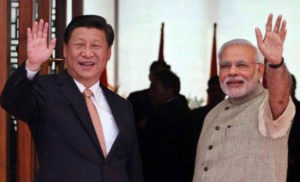
In September 2014, Indian Prime Minister Narendra Modi hosted a visit by Xi Jinping. China has been cultivating an amicable relationship with India since Modi came to power in May 2014
Source: ptinews.com
SINCE THE ELECTORAL victory of Indian Prime Minister Narendra Modi in May 2014, China has been cultivating an amicable relationship with Asia’s other giant. On a two-day state visit to India, 17–18 September 2014, Xi Jinping committed China to investing US$20 billion in India over the next five years. Early reports had the figure at US$100 billion, which would have dwarfed the US$35 billion deal secured by Modi in Japan at the end of August. Nonetheless, US$20 billion, a figure that includes both public and private investment, and will cover the construction of high-speed rail links and other infrastructure, represents a substantial increase from the US$400 million that China has invested in India over the past decade. Bi-lateral trade between the two countries, meanwhile, is expected to reach US$1 trillion by 2050.
On 18 September 2014, even as officials were distributing happy-looking photos of Xi and Modi relaxing in a garden with their wives to the media, 800 Chinese soldiers crossed the Line of Actual Control (LAC) under the auspices of building a ‘provincial road’ in Ladakh. The LAC has separated Chinese-held land from Indian territory since the 1962 border conflict between the two nations. The violation elicited a strong response from India, which dispatched 1,500 troops to the area. The Indian media reported on the incursion while Xi was still in the country. Xi addressed an emergency meeting of the country’s top military brass when he arrived back in Beijing on 21 September, sparking speculation in the foreign media that he had been unaware of the PLA troop movements. If so, the incident highlights problems in China’s military chain of command.
Unsurprisingly, the two sides made no tangible progress on the sensitive issue of border agreements. If trade and investment are hotting up, state-to-state relations remain relatively cool. Issues such as India’s hosting of the Dalai Lama in Dharamsala, China’s strong alliance with India’s rival Pakistan and ongoing border conflicts have historically plagued Sino-Indian relations. Xi’s visit, ground-breaking for a Chinese leader, was a small step in a new direction. That direction was perhaps confirmed at a regional meeting on Afghanistan in Beijing on 31 October, about which Ananth Krishnan writing for India Today noted: ‘China has appeared to rethink its long-held reluctance to discuss regional concerns, particularly in New Delhi and Kabul, on cross-border terrorism emanating from Pakistan.’
Another strategic alignment with China was announced ten days earlier on 21 October, when India and twenty other countries agreed to become founding members of the China-backed Asian Infrastructure Investment Bank (AIIB), a move seen as aimed at reducing the dependence on the Western-dominated World Bank and International Monetary Fund.
Notes
Ananth Krishnan, ‘Delhi, Kabul warn China: Pak maybe your ally but it exports terror’, India Today, 31 October 2014, online at http://indiatoday.intoday.in/story/afghanistan-meet-china-india-pakistan-terror-concerns-border-taliban-terrorism/1/398565.html


